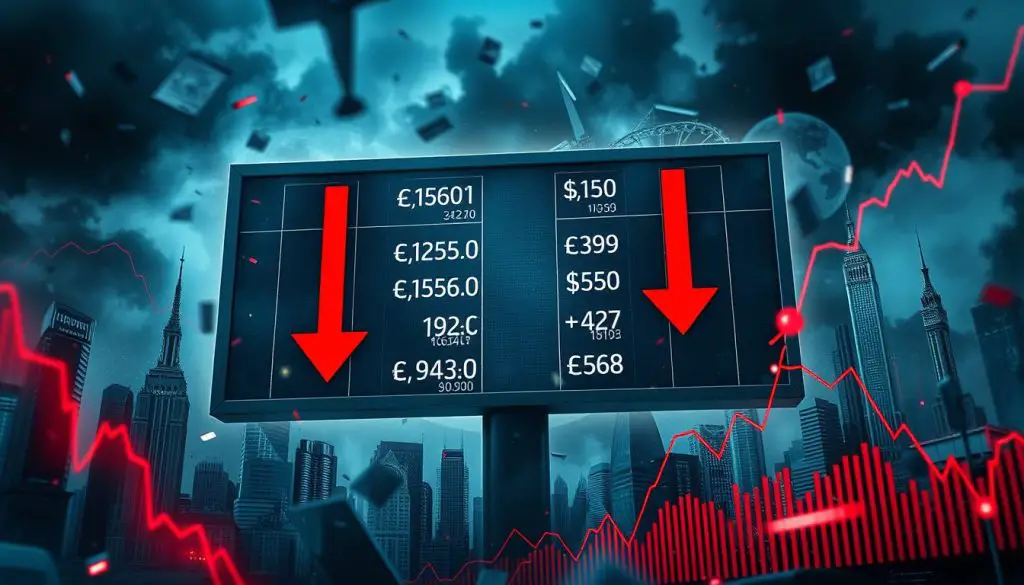In the fast-paced world of trading, how well you analyze the market can greatly affect your success. The stochastic indicator is a powerful tool for traders. It helps in making better trading decisions by setting it up right. This guide will show you how to use the best settings for the stochastic indicator to boost your trading strategies.
By learning to make the most out of the stochastic indicator, traders can make smarter choices. This leads to better results in different market conditions. It’s all about using the right settings to get the best out of this tool.
Key Takeaways
- Understanding how to optimize trades with the best stochastic settings improves your trading strategy.
- The stochastic indicator is a key part of technical analysis.
- Learning the best ways to set up stochastic parameters helps in making better market decisions.
- Maximizing stochastic effectiveness means adjusting settings based on the current market.
- Improving stochastic performance is about finding the right balance between accuracy and quick responses.
Understanding the Stochastic Indicator
The stochastic indicator is a key tool for technical analysis. It helps traders understand market trends and make better decisions. It’s important for both new and experienced traders to know how to use the stochastic indicator.
What is the Stochastic Indicator?
George Lane created the stochastic indicator in the late 1950s. It measures how a security’s closing price relates to its price range over time. This tool predicts market changes, helping traders know when to buy or sell.
How Does the Stochastic Indicator Work?
The stochastic indicator uses %K and %D lines to work. %K shows raw market momentum. %D is a moving average of %K, helping signal buy or sell times. Values range from 0 to 100, showing if the market is overbought or oversold.
Traders watch for when %K crosses %D to spot market changes. A %K above %D means a bullish trend, while a %K below suggests a bearish trend. Knowing these signs is key to using the stochastic indicator well.
The Importance of Optimal Stochastic Parameters
Setting up stochastic parameters right is key for a good trading strategy. The stochastic indicator is very sensitive to market changes. It needs to be set just right to tell real trends from false ones. This careful setup can greatly improve trading strategies, giving traders clearer signals.
Market analysis shows that the best stochastic settings change with the asset and market conditions. By doing deep analysis, traders can find the right settings for their trading goals. This has been shown to help reduce noise and make trading signals more reliable.
Experts say it’s important to keep checking and adjusting stochastic indicators. Looking at historical data is very helpful here. It shows how different settings worked in past market cycles. By tweaking these settings, traders can make their strategies better and get more consistent results.
Also, the financial markets are always changing, so a one-size-fits-all approach doesn’t work. By customizing stochastic settings through careful analysis, traders can keep up with changes and stay profitable.
How to Identify the Best Stochastic Settings?
Finding the right stochastic settings is key to good trading performance. It depends on market conditions and data from backtesting.
Assessing Market Conditions
It’s vital to know the market’s current state when setting stochastic parameters. The market’s volatility, volume, and overall environment affect the stochastic indicator’s success. For example, in markets that are very volatile, making the stochastic more sensitive can help catch better signals. In markets that are less volatile, you might want less sensitive settings.
Using technical indicators based on these market conditions can make trading decisions more reliable. Traders should decide if the market is trending or just moving sideways. This helps pick the right settings for their trading style.
Backtesting and Data Analysis
Backtesting and analyzing data is also crucial for finding the best stochastic settings. This means testing the settings on past market data to see how they perform. It helps figure out if the settings can handle different market situations and give consistent results.
Backtesting also helps evaluate trading performance. It shows how changing the stochastic settings affects profits. By looking at past data, traders can make their strategies better and more reliable over time.
Configuring Stochastic Indicator for Maximum Effectiveness
Understanding how to set up the stochastic indicator is key to getting strong trading signals. The look-back period is a crucial part of the indicator. It shows how many time periods to use when calculating its value. Traders often start with a 14-period look-back and adjust it based on their trading style and the market.
Here are some tips to improve the stochastic settings for better trading signals:
- Adjust Look-back Period: A shorter look-back period means more signals but also more noise. A longer period smooths out the ups and downs, giving fewer but more reliable signals.
- Smoothing the %K and %D Lines: Using moving averages on the %K and %D lines helps reduce sudden changes. This makes the signals clearer.
- Signal Thresholds: Setting levels for overbought and oversold (usually at 80 and 20) helps spot when the market might change direction. Changing these levels can make the indicator more responsive to the market.
Let’s look at how different settings can affect the indicator:
| Parameter | Short-Term Setting | Long-Term Setting | Effect on Signals |
|---|---|---|---|
| Look-back Period | 9 | 21 | Short-term: More signals but higher noise Long-term: Fewer signals but more reliable |
| %K Smoothing | 1 | 3 | Short-term: Immediate reactions Long-term: Smoothed responses |
| Thresholds | 85/15 | 75/25 | Short-term: Aggressive signals Long-term: Conservative signals |
It’s also important to think about the psychological side. Trying to catch every market move can lead to over-adjusting the settings. A balanced approach is key. By adjusting the settings based on your trading goals and the market, you can find the right balance. This way, you can make the most out of the stochastic indicator.
Fine-Tuning Stochastic Settings for Different Market Timelines
Adjusting stochastic settings for various market times is key for good trading. Whether you’re into short-term analysis or long-term investments, knowing how to set the best stochastic parameters can really boost your trading results.
Short-Term Trading Configurations
For short-term traders like day traders and scalpers, it’s all about catching fast price changes. They often use settings like 5, 3, 3 for quick entries and exits. The goal is to be fast and adjust to market changes quickly.
- K Period: 5
- D Period: 3
- Smooth: 3
A shorter period setting helps spot sharp, frequent market moves. This gives traders the speed they need for fast decisions. Keeping an eye on these settings helps make the most of short-term trades.
Long-Term Trading Configurations
Long-term trading, however, looks for big trends over short noise. Swing traders or those holding positions for a while might prefer settings like 14, 3, 3. These settings catch signals that last longer.
- K Period: 14
- D Period: 3
- Smooth: 3
These settings balance big trend capture with avoiding false signals from small price moves. Using these can help your trades fit a lasting long-term strategy.
It’s important to know the differences between these settings. For more on adjusting your stochastic settings, check out this detailed guide.
| Trading Style | Stochastic Settings | Market Focus |
|---|---|---|
| Day Trading | 5, 3, 3 | Short-Term Market Analysis |
| Swing Trading | 14, 3, 3 | Long-Term Investment Strategy |
Common Pitfalls in Stochastic Indicator Configuration
Traders often face challenges when setting up their stochastic indicators. Knowing these common issues can greatly improve trading accuracy. It also helps in preventing trading mistakes.
Avoiding Overfitting
Customizing stochastic settings too much to fit past data can lead to bad results in real trading. To prevent overfitting, it’s key to find a balanced approach. This approach should consider different market conditions.
Overfitting makes the stochastic indicator less able to adapt to real market changes. This increases the risk of getting wrong market signals. Experts suggest testing different settings and checking their performance over several market cycles before choosing one.
Misinterpreting Signals
One big challenge in trading is misreading stochastic signals. Many traders only look at these signals and not the bigger market picture. This leads to wrong decisions.
To get accurate market signals, use the stochastic indicator with other technical tools and analysis. Adding trend analysis, volume data, and other momentum indicators gives a fuller view of the market. This reduces the chance of making trading mistakes.
| Common Pitfall | Adverse Effect | Solution |
|---|---|---|
| Overfitting | Unreliable real-world performance | Test across diverse market conditions |
| Signal Misinterpretation | Erroneous trading decisions | Use complementary analytical tools |
By understanding and fixing these common issues, traders can better their strategy and actions. This leads to better trading results.
Best Practices for Setting Up Stochastic Parameters
In today’s fast-paced markets, setting up stochastic parameters right is crucial for traders. They should tweak their settings to fit the market’s mood. This ensures they work well as trading tools.
It’s important to keep an eye on the %K and %D lines. Adjusting the look-back period and fine-tuning overbought and oversold levels is also key. Regularly checking these settings keeps them working well in different trading situations.
| Market Condition | Parameter | Best Practice |
|---|---|---|
| Trending Markets | Look-Back Period | Increase to smooth out minor fluctuations |
| Volatile Markets | Overbought/Oversold Levels | Adjust levels to 80/20 for stronger signals |
| Consolidating Markets | %K and %D Settings | Use shorter periods for sensitive response |
Using these best practices for stochastic settings with other trading tools makes a trader’s strategy stronger. Being flexible with these practices helps traders handle the market’s changes well. Improve your trading by focusing on technical analysis and making your stochastic settings better.
Conclusion
This guide has shown how the stochastic indicator is a key tool for traders. It helps traders make better trading decisions. By understanding how it works and its benefits, traders can use it to analyze the market more accurately.
Choosing the right settings for the stochastic indicator is key to success in trading. This means finding settings that fit the market conditions. Using strategies like backtesting helps find the best settings. This reduces risks and increases potential gains.
It’s important to avoid mistakes like overfitting and misreading signals. These mistakes can hurt your trading results. Following best practices helps avoid these issues and keeps trading disciplined. By combining technical knowledge with ongoing learning, traders can use the stochastic indicator to their advantage. This leads to long-term growth in trading.
FAQ
What is the Stochastic Indicator?
The Stochastic Indicator is a tool that compares a closing price to its past prices. It was created by George Lane in the late 1950s. It helps traders spot when the market might change direction.
How Does the Stochastic Indicator Work?
This indicator uses two lines: %K and %D. %K shows the current price against past highs and lows. %D is a moving average of %K. Watching these lines helps traders see when prices are too high or too low.
Why are Optimal Stochastic Parameters Important?
The right settings for the Stochastic Indicator are key for good trading signals. They help avoid false signals and catch real market trends. This makes trading more consistent and profitable.
How Can I Identify the Best Stochastic Settings?
To find the best settings, look at market conditions and test them on past data. This helps traders pick settings that work well in different markets and meet their trading goals.
What Should I Consider When Configuring the Stochastic Indicator?
Think about the look-back period, smoothing, and signal thresholds when setting up the indicator. These choices affect how sensitive and reliable the signals are. Traders should balance timely signals with avoiding false positives.
How Do Short-Term and Long-Term Trading Configurations Differ?
Short-term trading uses shorter periods and is more sensitive, ideal for day trading. Long-term trading smooths out short-term changes, better for swing trading or investing in big trends. Each type should match the trader’s goals and timeline.
How Can I Avoid Common Pitfalls in Stochastic Indicator Configuration?
Avoid overfitting by not customizing settings too much. Don’t misread signals by ignoring the market or not checking with other tools. Adjust settings based on how well they perform over time to stay on track.
What are the Best Practices for Setting Up Stochastic Parameters?
For setting up stochastic parameters, backtest thoroughly and be flexible with your settings. Use it with other tools for a full analysis. Learn from others and improve your approach based on your trading results for success.






